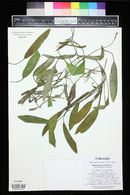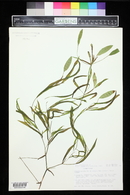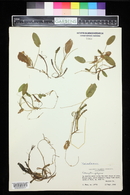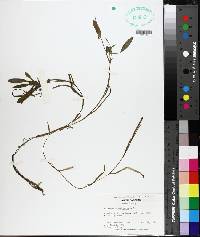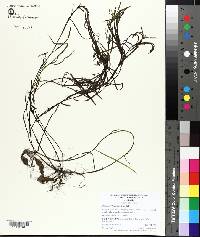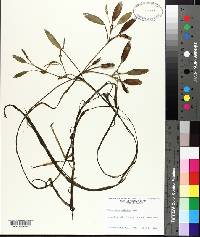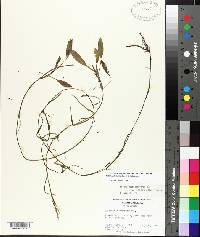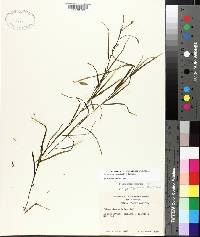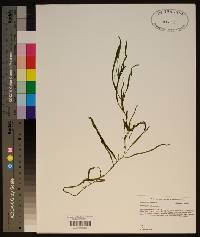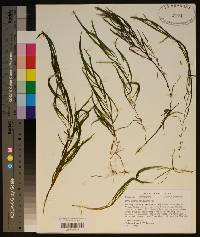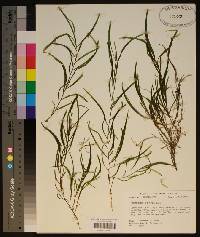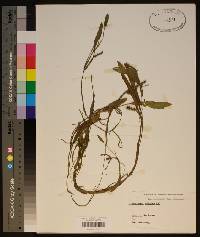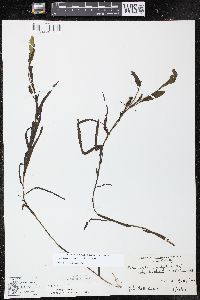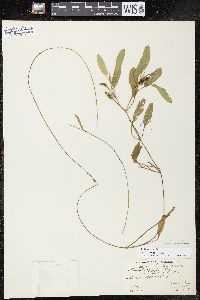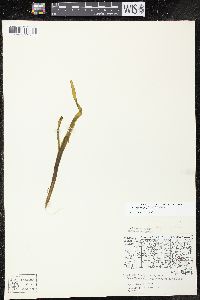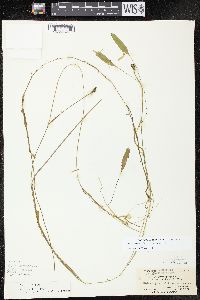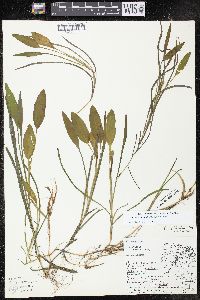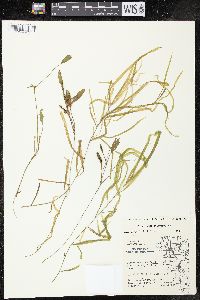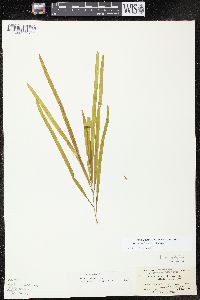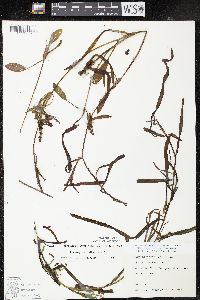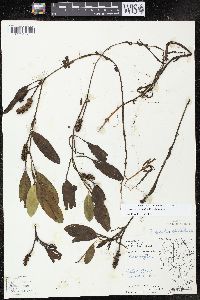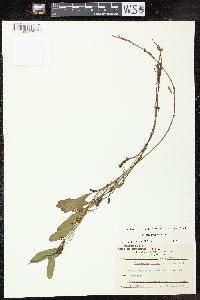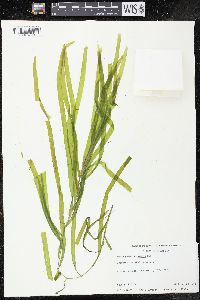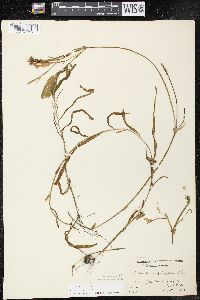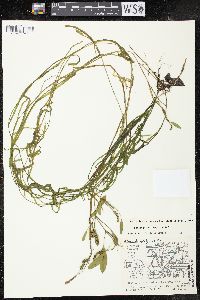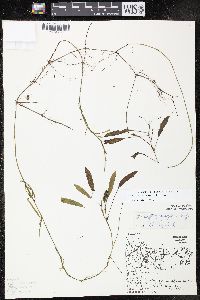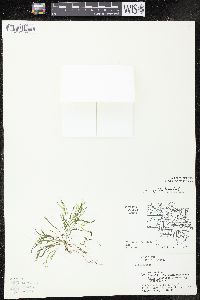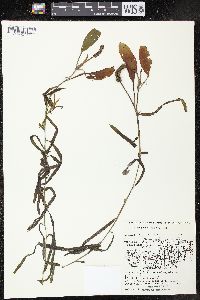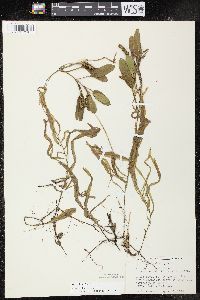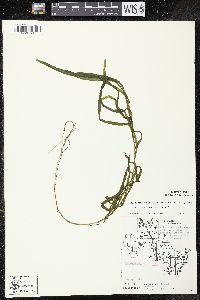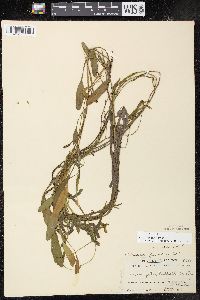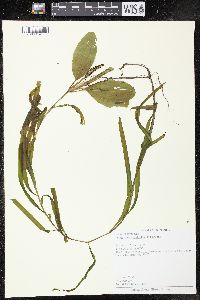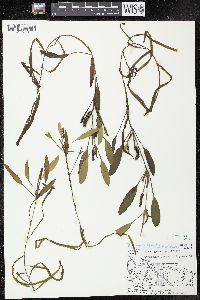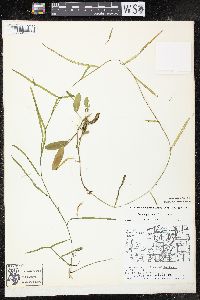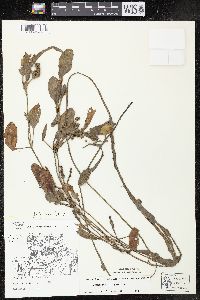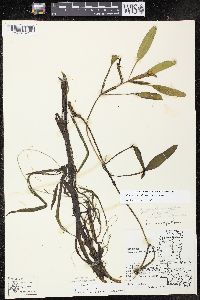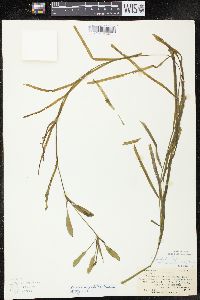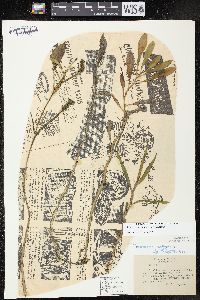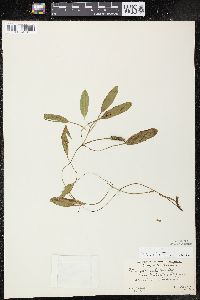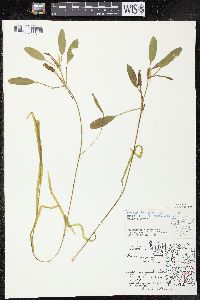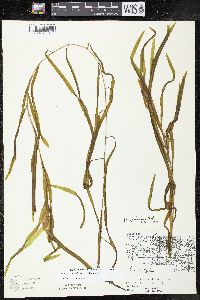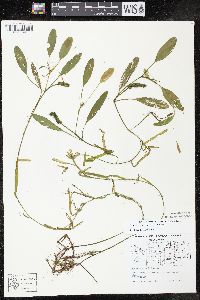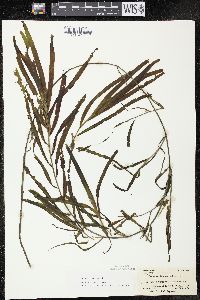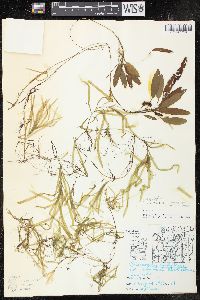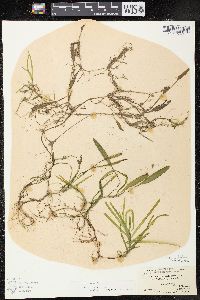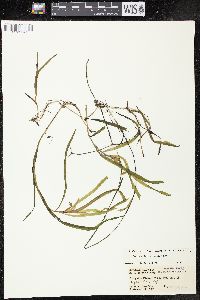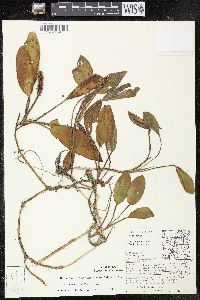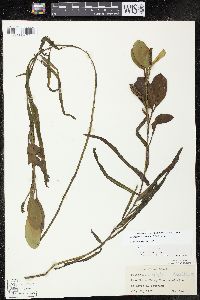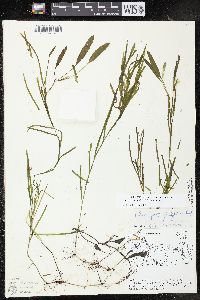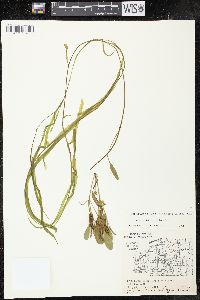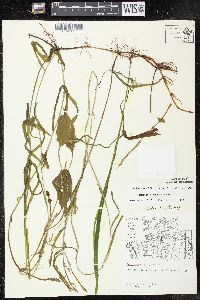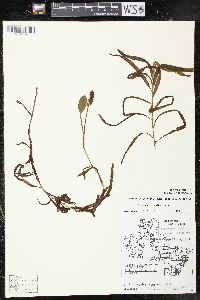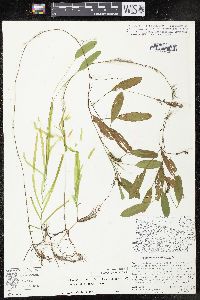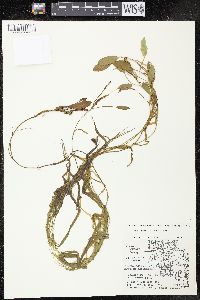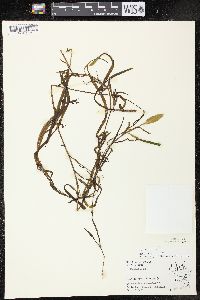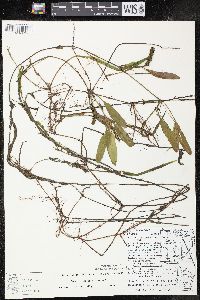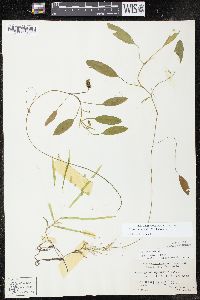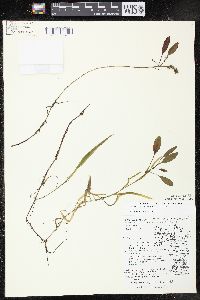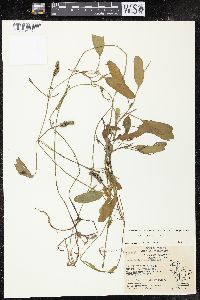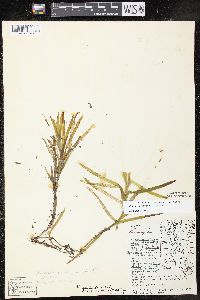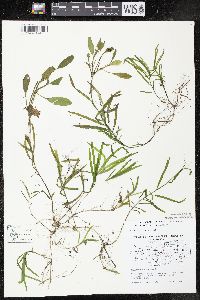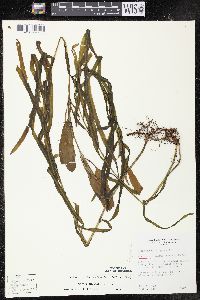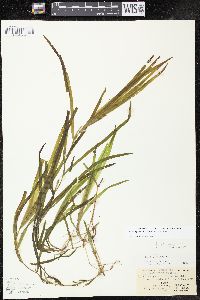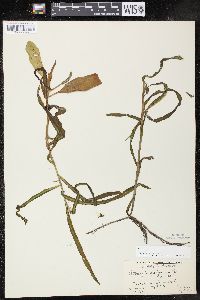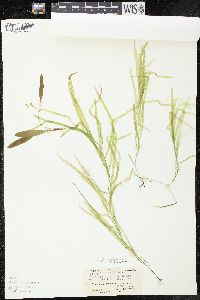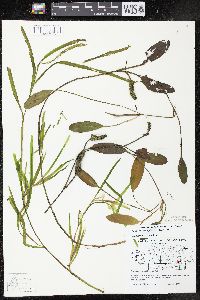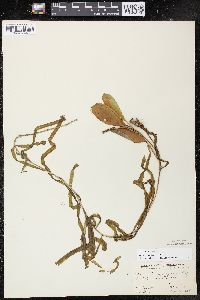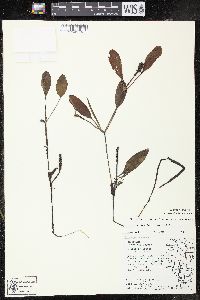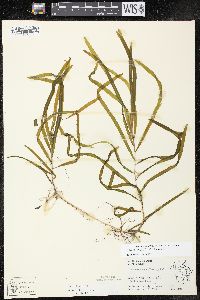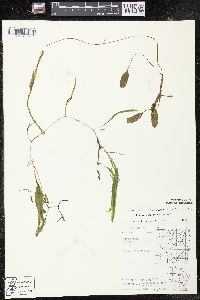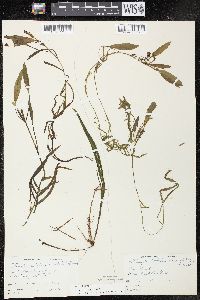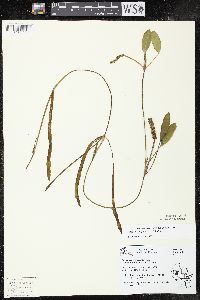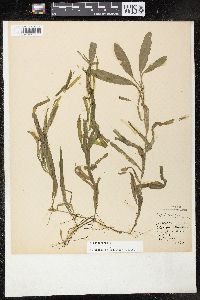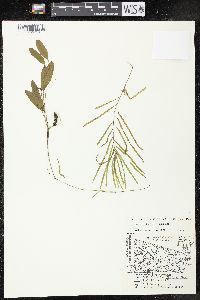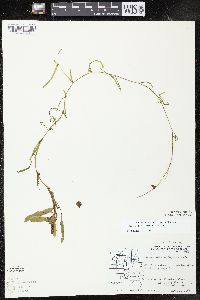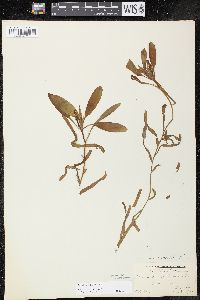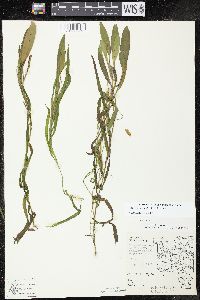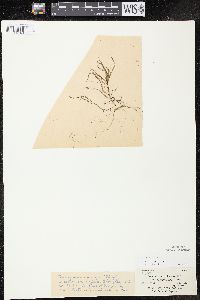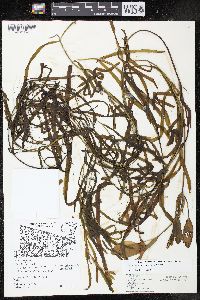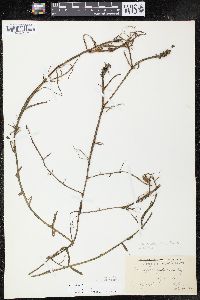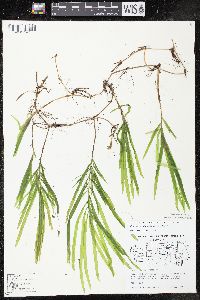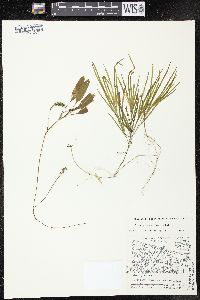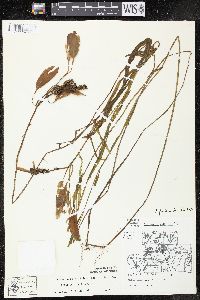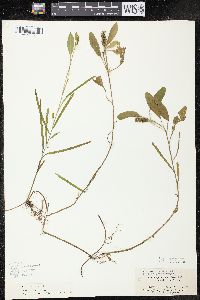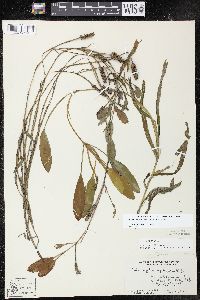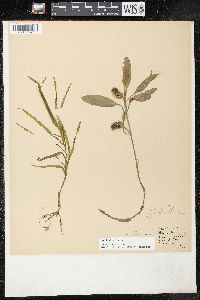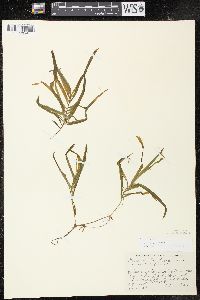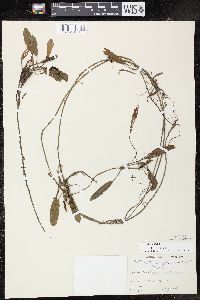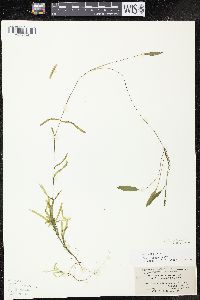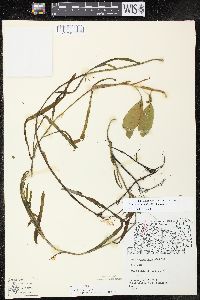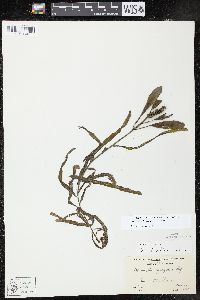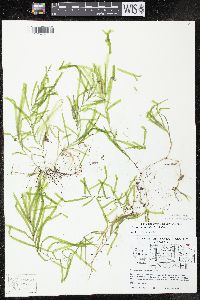
|
|
|
|
Family: Potamogetonaceae
Ribbon-Leaf Pondweed
[Potamogeton claytonii, morePotamogeton epihydrus var. typicus Fernald] |
Rhizomes present. Cauline stems flattened, without spots, 10--90 cm; glands absent. Turions absent. Leaves both submersed and floating or floating absent, ± spirally arranged. Submersed leaves sessile, lax; stipules persistent, inconspicuous, convolute, free from blade, red-brown, not ligulate, 1--3 cm, not fibrous, not shredding at tip, apex obtuse; blade red-brown to light green, linear, not arcuate, 5--22 cm ´ 1--10 mm, base not clasping, without basal lobes, margins entire, not crispate, apex not hoodlike, blunt to acute, lacunae present, broad band each side of midvein; veins 3--13. Floating leaves petiolate; petioles continuous in color to apex, 2--12.5 cm; blade adaxially light green, narrowly oblong-oblanceolate to elliptic, 2--8 cm ´ 4--20 mm, base acute, apex rounded or bluntly cuspidate; veins 11--41. Inflorescences unbranched, emersed; peduncles not dimorphic, axillary, erect, cylindric, 1.5--5(--16) cm; spikes not dimorphic, cylindric, 0.8--4 cm. Fruits sessile, greenish brown, round-obovoid, flattened, abaxially and laterally keeled, 2.5--4.5 ´ 2--3.6 mm, lateral keels without sharp points; beak erect, 0.5 mm; sides without basal tubercles; embryo with less than 1 full spiral. 2n = 26. Flowering summer--fall. Still or flowing waters of lakes, ponds, streams, and rivers; 10--1900 m; St. Pierre and Miquelon; B.C., Man., N.B., Nfld. and Labr., N.S., Ont., P.E.I., Que., Sask.; Ala., Alaska, Calif., Conn., Colo., Del., Fla., Ga., Idaho, Ind., Iowa, La., Maine, Md., Mass., Mich., Minn., Miss., Mont., N.H., N.J., N.Y., N.C., Ohio, Oreg., Pa., R.I., S.C., S.Dak., Tenn., Utah, Vt., Va., Wash., W.Va., Wis., Wyo; Europe. No specimens have been seen from Maryland, but the species is to be expected there. Two varieties, Potamogeton epihydrus var. epihydrus and var. ramosus, have been recognized. These prove not to be distinct. Both varieties often grow in the same body of water in the same population. The wider-leaved plants often occur in more alkaline waters. Two hybrids, P. epihydrus var. nuttallii × P. gramineus and P. epihydrus × P. nodosus (= P. ×subsessilis Hagström), have been described. Potamogeton epihydrus is a common species of lakes and streams of northern United States and southern Canada. It extends southward in the eastern United States to Louisiana and Alabama. Potamogeton epihydrus is one of our more easily recognized species: it has floating leaves, linear submersed leaves, and fruits with an embryo with one full spiral or less. The only other North American pondweed with a similar set of characteristics is P. tennesseensis, which differs from P. epihydrus by the former having long tapering apices in the submersed leaves whereas the latter has blunt to acute apices.
Perennial submersed aquatic herb with elongate rhizomes 10 cm - 1 m tall Stem: slender, somewhat flattened, branched, jointed. Inflorescence: an upright, dense, cylindrical spike of flowers, emersed, unbranched, 1 - 4 cm long, on an axillary stalk. Stalk cylindrical, 1.5 - 5 cm long, about as thick as stem. Spikes numerous. Flowers: greenish, tiny. Stamens four. Anthers two-chambered, with four edge-to-edge sepal-like outgrowths. Fruit: an achene, stalkless, greenish brown, 2.5 - 4.5 mm long, 2 - 3.6 mm wide, obliquely reverse egg-shaped, flattened, shallowly pitted, keeled, with an upright, 0.5 mm long beak. Keels three, central one sharp, lateral ones low. The embryo contains one full spiral or less. Submersed leaves: more or less arranged spirally, stalkless, translucent, reddish brown to light green, 5 - 22 cm long, 1 - 10 mm wide, linear with a rounded to pointed tip, three- to thirteen-veined. Stipules free from leaf blade, reddish brown, rolled up, 1 - 3 cm long. Floating leaves: (if present) numerous, more or less arranged spirally, on 2 - 12.5 cm long stalks, 2 - 8 cm long, to 2 cm wide, narrowly reverse lance-shaped to elliptic to somewhat spatula-shaped with a narrowing base and rounded tip (sometimes with a short, tiny point), 11- to 41-veined, leathery, firmer than submersed leaves. Similar species: Easily identified by its combination of floating leaves, linear submersed leaves, and fruit embryos with one full spiral or less. Flowering: June to September Habitat and ecology: Very rare in the Chicago Region. Has been found in a creek in slow moving water. May also be found in quiet lakes and ponds. Occurence in the Chicago region: native Notes: Plants in the genus Potamogeton are very important to wildlife, offering habitat and food for many aquatic animals. Etymology: Potamogeton comes from the Greek words potamos, meaning river, and geiton, meaning neighbor, referring to the habitat of these plants. Epihydrus means "upon the water." Author: The Morton Arboretum Stem slender, somewhat flattened, often branched, to 2 m; rhizomes elongate; lvs sessile, linear, to 2 dm, 2-10 mm wide, 5-13-nerved, the midrib flanked by a pair of
conspicuous bands (each 1-2+ mm wide) of pale green or translucent lacunar cells; stipules 1-3 cm, free; floating lvs usually numerous, linear-elliptic to somewhat spatulate or narrowly obovate, 3-7 cm נ8-20 mm, 11-27-veined, mostly obtuse, narrowed below to a slender petiole about as long as the blade; peduncles about as thick as the stem, 2-5 cm, seldom longer; spikes numerous, cylindric, dense, 1-3 cm; frs obliquely obovoid, 2.5-4 mm, shallowly pitted, the sharp dorsal keel flanked by a pair of lower ones; 2n=26. Ponds and slow streams; Nf. to Que. to s. Alas., s. to Ga., La., and Calif. Gleason, Henry A. & Cronquist, Arthur J. 1991. Manual of vascular plants of northeastern United States and adjacent Canada. lxxv + 910 pp. ©The New York Botanical Garden. All rights reserved. Used by permission. From Flora of Indiana (1940) by Charles C. Deam Our only specimen is one collected in 1936 by R. M. Tryon, Jr. It was found in State Line Creek in La Porte County. It has been reported but, no doubt, all other reports should be referred to other species. …… Indiana Coefficient of Conservatism: C = 10 Wetland Indicator Status: OBL |

